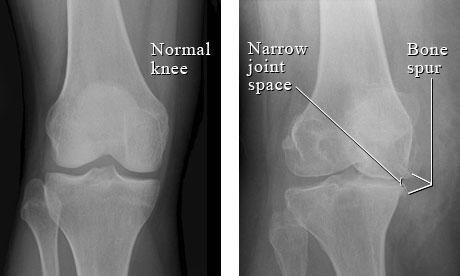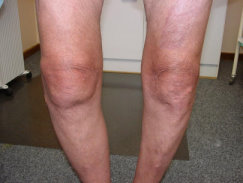Development of osteoarthritis
In osteoarthritis the articular cartilage becomes thin and worn. In the early stages it is quite possible for the patient to be totally unaware that the process is occurring. The reason for that is that there are no nerves within articular cartilage. The condition can therefore progress slowly over many years until eventually the cartilage wears away exposing the underlying bone. When this happens and indeed shortly before the cartilage has all gone, bone pain starts to occur from the sensory nerves under the surface of the bone.
Not all osteoarthritis progresses slowly and insidiously. In many cases pain is an earlier feature due to irritation of the soft tissue including the synovial membrane by wear fragments which come off the surface of the articular cartilage and set up an inflammatory reaction.
Pain can also occur from the presence of bony spurs or osteophytes which are nature’s way of trying to repair osteoarthritic joints. In such cases aching or a burning sensation can occur. The osteophytes can also limit the range of movement and in many cases the knee no longer flexes or extends quite fully.
In many cases chronic swelling occurs and this distends the tissues causing stiffness, pain and limitation in movement.
Tears of the menisci are a feature of osteoarthritis and can occur with relatively minor force causing sudden pain, locking or giving way of the knee. As osteoarthritis progresses the joint can become deformed giving rise to a knock knee or bow leg position.
|

|
|
Osteoarthritis of medial side
|
|

|
|
Osteoarthritis medial side right knee
causing a bow leg deformity
|
Conservative Treatment
In the early stages of osteoarthritis before pain becomes too disabling non-surgical treatments can enable the patient to ‘keep going’. These include:
-
Simple painkillers
-
Light exercise
-
Maintenance of muscle tone
-
Non-steroidal anti-inflammatory tablets
-
Locally applied creams and gels
-
Glucosamine & chondroitin sulphate tablets
-
Walking aids
-
Changes to footwear
-
Physiotherapy
-
Acupuncture
-
Hyaluronan injections
-
Steroid injections
Surgery for osteoarthritis
Surgery is an option in a number of circumstances. Where the condition is not too advanced and where there are loose fragments, meniscal tears or bony spurs impeding movement within the joint arthroscopy may be appropriate. Where only part of the joint is affected a partial knee replacement can be undertaken replacing only the affected part of the knee while preserving the ligaments. Where all compartments of the knee joint are involved a total knee replacement may become necessary.
Rarely, if the joint may require fusion where the ends of the femur and tibia are permanently joined together. This is usually a salvage procedure after failed previous surgery.
TEXT Copyright London Knee Clinic® 2014